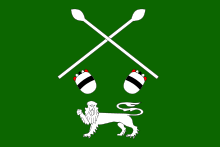- Ankole
-
- For the breed of cattle, see Ankole-Watusi (cattle).
Ankole, also referred to as Nkore, is one of four traditional kingdoms in Uganda. The kingdom is located in the southwestern Uganda, east of Lake Edward. It was ruled by a monarch known as The Mugabe or Omugabe of Ankole. The kingdom was formally abolished in 1967 by the government of President Milton Obote, and is still not officially restored.[1] The people of Ankole are called Banyankole (singular: Munyankole) in Runyankole language, a Bantu language.
On October 25, 1901, the Kingdom of Nkore was incorporated into the British protectorate of Uganda by the signing of the Ankole agreement.[2]
Due to the reorganisation of the country by Idi Amin, Ankole no longer exists as an administrative unit. It is divided into six districts: Bushenyi District, Ntungamo District, Mbarara District, Kiruhura District, Ibanda District and Isingiro District.
History of pre-colonial ethnic relations in Ankole
The pastoralist Hima (also known as Bahima) established dominion over the agricultural Iru (also known as Bairu) some time before the nineteenth century. The Hima and Iru established close relations based on trade and symbolic recognition, but they were unequal partners in these relations. The Iru were legally and socially inferior to the Hima, and the symbol of this inequality was cattle, which only the Hima could own. The two groups retained their separate identities through rules prohibiting intermarriage and, when such marriages occurred, making them invalid.
The Hima provided cattle products that otherwise would not have been available to Iru farmers. Because the Hima population was much smaller than the Iru population, gifts and tribute demanded by the Hima could be supplied fairly easily. These factors probably made Hima-Iru relations tolerable, but they were nonetheless reinforced by the superior military organization and training of the Hima.
The kingdom of Ankole expanded by annexing territory to the south and east. In many cases, conquered herders were incorporated into the dominant Hima stratum of society, and agricultural populations were adopted as Iru or slaves and treated as legal inferiors. Neither group could own cattle, and slaves could not herd cattle owned by the Hima.
Ankole society evolved into a system of ranked statuses, where even among the cattle-owning elite, patron-client ties were important in maintaining social order. Men gave cattle to the king (mugabe) to demonstrate their loyalty and to mark life-cycle changes or victories in cattle raiding. This loyalty was often tested by the king's demands for cattle or for military service. In return for homage and military service, a man received protection from the king, both from external enemies and from factional disputes with other cattle owners.
The mugabe authorized his most powerful chiefs to recruit and lead armies on his behalf, and these warrior bands were charged with protecting Ankole borders. Only Hima men could serve in the army, however, and the prohibition on Iru military training almost eliminated the threat of Iru rebellion. Iru legal inferiority was also symbolized in the legal prohibition against Iru owning cattle. And, because marriages were legitimized through the exchange of cattle, this prohibition helped reinforce the ban on Hima-Iru intermarriage. The Iru were also denied highlevel political appointments, although they were often appointed to assist local administrators in Iru villages.
The Iru had a number of ways to redress grievances against Hima overlords, despite their legal inferiority. Iru men could petition the king to end unfair treatment by a Hima patron. Iru people could not be subjugated to Hima cattle-owners without entering into a patron-client contract.
A number of social pressures worked to destroy Hima domination of Ankole. Miscegenation took place despite prohibitions on intermarriage, and children of these unions (abambari) often demanded their rights as cattle owners, leading to feuding and cattle-raiding. From what is present-day Rwanda groups launched repeated attacks against the Hima during the nineteenth century. To counteract these pressures, several Hima warlords recruited Iru men into their armies to protect the southern borders of Ankole.
References
- ^ The Observer Media Ltd. :: The Weekly Observer :: Uganda's Top Resource site
- ^ The Ankole Agreement 1901
 This article incorporates public domain material from websites or documents of the Library of Congress Country Studies.
This article incorporates public domain material from websites or documents of the Library of Congress Country Studies.External links
Categories:- Ankole
- Sub-regions of Uganda
- Ugandan monarchies
- Ethnic groups in Uganda
Wikimedia Foundation. 2010.


